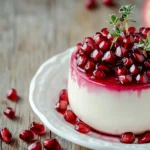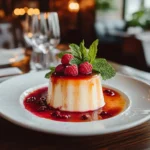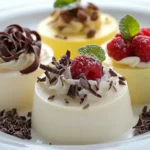Creamy, melt-in-your-mouth desserts have always appealed to me, and Gordon Ramsay Panna Cotta is absolutely the perfect match. Though surprisingly easy to create at home, this exquisite Italian dessert looks excellent. You know he demands a silky-smooth texture with just the correct jiggle—no rubbery consistency, no graininess, just perfection—if you have ever witnessed Ramsay prepare this dish. I recall my first Panna Cotta effort. For a home cook like me, I was sure it was too delicate and erratic. Trust me, though, if you follow the correct procedures, it’s nearly perfect. With little ingredients and work, this dish offers restaurant-quality results directly in your kitchen. And the nicest thing is to make it your own and get imaginative with flavors and toppings. If you love creamy, no-bake desserts, you might also enjoy these Bavarois and Panna Cotta recipes for more inspiration.
Is bavarian cream the same as panna Cotta?
No, bavarian cream is made with custard and whipped cream, while panna cotta is made with cream and gelatin.
So, if you’re ready to wow your guests or treat yourself to something unique, let’s explore this silky, opulent, and quite tasty Gordon Ramsay Panna Cotta recipe.

Why I Love this Gordon Ramsay Panna Cotta Recipe
Panna cotta is of excellent quality. Like the nicest bits of pudding and custard mixed together, it is creamy but light, solid but delicate. Gordon Ramsay’s Panna Cotta distinguishes itself nonetheless by its simplicity and accuracy. Ramsay stresses quality ingredients and technique; he does not overcomplicate everything.
This dish is great because:
The processes are simple, and you need a handful of ingredients, which surprises me.
It’s flexible; you could create a dairy-free version, play with several toppings, or mix flavors.
This dessert makes you feel as though you are a Michelin-star cook in your kitchen—restaurant quality.
And let’s be honest—you know it’s excellent if Gordon Ramsay says it’s worth doing.
Let’s explore this silky, opulent, and quite mouthwatering Gordon Ramsay Panna Cotta dish.

Key Ingredients for Gordon Ramsay Panna Cotta
1. Heavy Cream: The backbone of any Panna Cotta is heavy cream. I always use full-fat heavy cream because it gives the dessert that luscious, creamy texture. If you want a lighter version, you can replace half with whole milk.
2. Sugar: A little goes a long way. Gordon Ramsay’s version isn’t overly sweet—just enough to enhance the flavors without overpowering them.
3. Vanilla Bean or Extract: Nothing beats real vanilla bean seeds for a deep, aromatic flavor. But if you don’t have any on hand, high-quality vanilla extract works just fine.
4. Gelatin: This is what gives Panna Cotta its signature set. Unflavored gelatin powder is the easiest to use, but if you prefer gelatin sheets, you’ll need to adjust the quantity.
5. Milk: A small amount of milk helps dissolve the gelatin and balances the richness of the cream. I typically use whole milk, but you can swap it with almond or coconut milk for a dairy-free version.
6. Citrus Zest (Optional): For an extra layer of freshness, a bit of lemon or orange zest gives a subtle brightness to the dessert.
How to Make Gordon Ramsay Panna Cotta
1. Bloom the Gelatin: In a small bowl set over cold milk, bloom the gelatin by sprinkling powder and letting it sit for five to ten minutes. This lets it soften and absorb liquid, thereby guaranteeing a smooth consistency when combined with the cream.
2. Heat the Cream Mixture: In a saucepan, combine heavy cream, sugar, and vanilla over medium-low heat. Stir gently until the sugar completely dissolves. You don’t want it to boil—just warm it enough to blend everything together.
Pro Tip: If using vanilla bean, scrape the seeds into the mixture and drop in the pod for extra flavor.
3. Dissolve the Gelatin: Once the cream is warm, remove it from heat and stir in the gelatin-milk mixture. for a silky texture, it’s important to whisk until fully dissolved.
Avoid This Mistake: If the gelatin doesn’t dissolve properly, your Panna Cotta may end up grainy or have an uneven set.
4. Strain and Pour: For a smooth consistency, strain the mixture through a fine-mesh sieve before pouring it into ramekins or dessert glasses. This removes any undissolved gelatin or vanilla bean bits.
5. Chill and Set: Cover the ramekins with plastic wrap and refrigerate for at least 4 hours, but overnight is best. The Panna Cotta should be firm yet wobbly—not stiff or rubbery.
6. Serve and Enjoy: To unmold, dip the ramekins in warm water for a few seconds, then gently run a knife around the edges before flipping onto a plate. If serving in glasses, just add your favorite toppings and enjoy.
Chef’s Tips & Variations for Gordon Ramsay Panna Cotta
Now that you have mastered the basics, it is time to take your Gordon Ramsay Panna Cotta to the next level. With a few simple adjustments, you can customize this dessert to suit different tastes and dietary preferences.
Chef’s Tips & Variations for Gordon Ramsay Panna Cotta
Now that you have mastered the basics, it is time to take your Gordon Ramsay Panna Cotta to the next level. With a few simple adjustments, you can customize this dessert to suit different tastes and dietary preferences.
Pro Tips for the Perfect Panna Cotta
- Achieve the Right Texture: The perfect Panna Cotta should have a slight wobble but still hold its shape. If it turns out too firm, slightly reduce the amount of gelatin next time.
- Use High-Quality Ingredients: Since this dessert relies on just a few ingredients, the quality of the cream, vanilla, and gelatin makes a significant difference in the final taste.
- Infuse Flavors for Depth: Instead of only using vanilla, try infusing the cream with lavender, cinnamon, or coffee beans for added complexity. Allow the infusion to steep in the warm cream for about ten minutes before straining.
- Strain for a Smooth Consistency: To achieve the silkiest texture, always strain the mixture before pouring it into molds. This step ensures there are no undissolved gelatin bits or clumps.
- Use Glasses for Effortless Serving: If you prefer to skip the process of unmolding Panna Cotta, serve it in elegant glasses or small jars for a sophisticated presentation.
Delicious Variations to Try
Panna Cotta is quite flexible and permits many artistic variants. These are some suggestions for experimenting:
1. Chocolate Panna Cotta: For chocolate aficionados, a rich, creamy variation.
How might one make it? Melt three ounces of dark chocolate into the cream then mix with the gelatin. Stirring till totally smooth will give a luscious twist.
2. Coffee-Infused Panna Cotta: A bold and aromatic variation for those who love espresso-based desserts.
How to Make It: Add one teaspoon of instant espresso powder while heating the cream to infuse it with deep coffee flavor.
3. Citrus Panna Cotta: A bright and refreshing option with a hint of citrus.
How to Make It: Stir in one teaspoon of orange or lemon zest into the warm cream before straining for a subtle, zesty aroma.
4. Dairy-Free Coconut Panna Cotta: A plant-based alternative that offers a creamy, tropical flavor.
How to Make It: Replace the heavy cream with coconut cream and use agar-agar instead of gelatin for a vegan-friendly version.
For a rich and indulgent version, try this Chocolate Panna Cotta recipe that takes this classic dessert to the next level.
Storing, Reheating & Freezing Gordon Ramsay Panna Cotta
Panna Cotta is an excellent make-ahead dessert since it stores well and remains fresh for days.
How to Store Panna Cotta in the Fridge
- Keep the ramekins covered with plastic wrap or stored in an airtight container to prevent them from absorbing other fridge odors.
- Properly stored, Panna Cotta remains fresh for up to four days, making it ideal for preparing in advance.
Can You Freeze Panna Cotta?
Freezing is possible, but it may slightly alter the smooth, creamy texture. The flavor will remain intact, but the consistency could be slightly firmer after thawing.
How to Freeze:
- Wrap each ramekin tightly with plastic wrap and place them in a freezer-safe container.
- Store for up to two months.
- To serve, thaw overnight in the refrigerator rather than at room temperature to prevent separation.
Frequently Asked Questions about Gordon Ramsay Panna Cotta
1. Why Didn’t My Panna Cotta Set?
If your Panna Cotta did not set properly, it may be due to the following reasons:
- Not enough gelatin: Ensure you are using the correct measurement for the amount of liquid.
- Overheated gelatin: If the mixture was too hot when the gelatin was added, it may have lost its setting properties.
- Insufficient chilling time: Allow at least four hours in the refrigerator, though overnight chilling yields the best results.
2. Can I Make Panna Cotta Without Gelatin?
Yes, Panna Cotta can be made without gelatin by using agar-agar, a plant-based thickener. However, agar sets firmer than gelatin, so slight adjustments may be necessary to achieve the desired texture.
3. How Can I Make My Panna Cotta Extra Creamy?
To achieve the creamiest consistency, use full-fat heavy cream and strain the mixture before pouring it into molds. Additionally, avoid boiling the cream, as excessive heat can affect the smooth texture.
What to Serve with Gordon Ramsay Panna Cotta
Although Panna Cotta is delicious on its own, pairing it with the right toppings and sides enhances its flavors.
Toppings That Elevate the Flavor
- Berry Coulis: A drizzle of pureed strawberries, raspberries, or blueberries adds a tangy contrast.
- Caramel Sauce: A rich caramel drizzle complements the creamy base beautifully.
- Chocolate Shavings: Finely grated dark chocolate or cocoa nibs add a touch of decadence.
- Toasted Coconut: A crunchy, nutty element that pairs well with vanilla or citrus flavors.
- Citrus Segments: Fresh orange or grapefruit slices add a refreshing contrast.
Best Drink Pairings
- Sweet Dessert Wines: A chilled Moscato d’Asti or Prosecco balances the richness of the dessert.
Cappuccino or Espresso: The bitterness of coffee emphasizes the creamy smoothness of Panna Cotta..
- Herbal Tea: Teas such as chamomile or mint offer a soothing pairing.
Conclusion: Try Gordon Ramsay Panna Cotta Today
Gordon Ramsay Panna Cotta recipe proves that sometimes the most impressive desserts are also the simplest. With just a handful of ingredients, you can create a smooth, elegant, and restaurant-quality dessert at home.
Whether you stick to the classic vanilla version or experiment with chocolate, coffee, or citrus twists, this Panna Cotta is guaranteed to impress. Since it is a make-ahead dessert, it is perfect for dinner parties, romantic occasions, or simply indulging in a special treat.
You might find yourself repeatedly creating this recipe after you try it. Any dessert enthusiast should always have this basic yet elegant and versatile item on hand. Now, compile your components and have a delightfully silky Panna Cotta with exactly the correct wobbling level.
Print
Gordon Ramsay Panna Cotta Recipe
- Total Time: 15 minutes
- Yield: 4 servings 1x
- Diet: Vegetarian
Description
This Gordon Ramsay Panna Cotta recipe is smooth, creamy, and incredibly easy to make. With just a few ingredients, you can create a restaurant-worthy dessert perfect for any occasion.
Ingredients
Panna Cotta Base
- 2 cups heavy cream
- ¼ cup sugar
- 1 teaspoon vanilla extract or 1 vanilla bean
- ½ cup whole milk
- 2 ½ teaspoons unflavored gelatin
Optional Toppings
- Fresh berries
- Caramel sauce
- Chocolate shavings
- Citrus zest
Instructions
Bloom the Gelatin
Sprinkle gelatin over the milk and let it sit for 5-10 minutes until softened. This helps ensure a smooth consistency.Heat the Cream Mixture
In a saucepan, combine heavy cream, sugar, and vanilla over medium-low heat. Stir gently until the sugar dissolves. Do not boil.Incorporate the Gelatin
Remove the saucepan from heat and whisk in the gelatin mixture until fully dissolved. Strain for a silky texture.Pour and Chill
Pour the mixture into ramekins, cover with plastic wrap, and refrigerate for at least 4 hours or overnight.Serve and Enjoy
To unmold, dip the ramekins in warm water for a few seconds, then invert onto a plate. Serve with your favorite toppings.
Notes
- Do not boil the cream, as it can cause separation.
- Always bloom the gelatin to ensure it dissolves properly.
- For a dairy-free version, substitute coconut cream and use agar-agar instead of gelatin.
- Prep Time: 10 minutes
- Cook Time: 5 minutes
- Category: Dessert
- Method: No-Bake
- Cuisine: Italian
Nutrition
- Serving Size: 1 ramekin
- Calories: 320
- Sugar: 14g
- Sodium: 40mg
- Fat: 28g
- Saturated Fat: 18g
- Unsaturated Fat: 8g
- Trans Fat: 0g
- Carbohydrates: 18g
- Fiber: 0g
- Protein: 4g
- Cholesterol: 85mg





